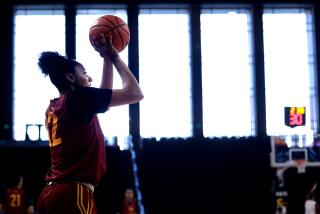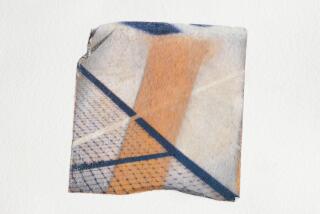TENNIS AND WINNING : Katrina’s World : The South L.A. 12-year-old must contend with gunfire near her practice court and has difficulty paying for tournament trips. Still, she is seeded among the nation’s Top 10 amateur players in her age group.
- Share via
At age 5, when some girls are still playing with dolls and tea sets, Katrina Nimmers slammed doors, threw temper tantrums and pouted until her parents pulled her from etiquette classes at Los Angeles Southwest Community College and took her to play tennis.
Her interest spurred on by trophies her father brought home from local amateur tennis tournaments, Katrina, a South Los Angeles resident, took to the sport immediately, tirelessly hitting tennis balls for hours and eventually coaxing her parents into almost daily sessions.
“I didn’t want her to play,” said her father, Michael. “We thought she would get tired and forget about tennis. She didn’t.”
As proof of her relentless drive to play tennis and win, Katrina, now 12, is ranked third by the United States Tennis Assn. among junior players in Southern California. And while the association no longer keeps official national junior rankings, Katrina has been invited to all major outdoor USTA junior national tennis tournaments in the last two years and has been seeded among the Top 10 amateur players in the 14-and-under age group in the nation.
“When we started we just wanted to do the best we could,” Nimmers said. “We had no idea that she would do so well.”
But how much further Katrina progresses is in doubt. In a game that has become known for domineering parents who push their children to tennis glory at country clubs, expensive clinics and South Florida tennis schools, talent and determination may not be enough to move Katrina from amateur to professional ranks.
The conditions under which Katrina practices are a far cry from the facilities where her competitors train. She and her father say they routinely hear gunshots near the Green Meadows Recreation Center, a public tennis court on E. 89th St. in South Los Angeles where they practice, and have been forced to lie on the ground on several occasions, fearing for their safety.
“Few people have had to go through what we’ve experienced,” Nimmers said. “If she makes it in South-Central, I know she can do anything.”
Kip Brady, a USTA juniors coach, agreed. Moved by the Nimmers’ story, he offered Katrina free lessons on Tuesdays and Thursdays at the Rolling Hills Estates Plaza Racquet Club.
“I can’t imagine what she’s been through to get here,” said Brady, who characterized Katrina as a quick player who is “talented enough to go all the way.”
Although Brady’s free lessons help, there are still daunting financial concerns. While some parents spend a minimum $40 per session for tennis lessons and can spend as much as $7,000 to take their children to tournaments in other states, Nimmers, an RTD bus driver who makes $34,000 a year, struggles to make ends meet and keep his daughter’s tennis dreams alive.
Though the USTA does not allow junior tennis players to accept gifts or receive payments for appearances, juniors can have their expenses paid by private organizations such as country clubs and sporting goods manufacturers. Except for one donation for a plane flight and an equipment sponsorship from a racket company, the Nimmers have had to scrape together money and borrow from friends to pay air fare to national tournaments.
With no money for hotel accommodations and registration fees, Katrina, who has been invited to the prestigious Easter Bowl juniors tournament April 12-14 in Doral Beach, Fla., will not be able to attend.
“If we are going to fulfill our dreams we have to have help,” her father said. “It is so disappointing because she should be there.”
A quiet girl who sports a Mickey Mouse watch she received for Christmas, Katrina enjoys playing hide-and-seek with her sister and can’t get enough Judy Blume books. Although she is nonchalant about her success, she is intense about winning.
“I like to win 200%,” said Katrina, a seventh-grader in Palms Middle School’s math and science magnet program. “I hate to lose more than anything. I would like to be a pro.”
Her success is no small accomplishment considering that many coaches in search of top college and professional prospects say Southern California is one of the toughest divisions for amateur tennis in the nation.
“Southern California is the premiere place in the world for juniors tennis,” said Kevin Lyons, director of player development for the United States Tennis Assn. of Southern California. “The competition is stiff.”
Despite her talent, Katrina’s parents have set priorities for her. When Katrina’s grades fell during her first semester at Palms Junior High, her father curtailed her tennis practice and kept her from playing tournaments. “Education comes first in our family,” Nimmers said.
After a recent practice session at Green Meadows, Katrina, who hits powerful ground strokes and enjoys playing the net, said she was back on track with an A average.
Although her family cannot afford to take her to the Florida tournament this spring, Katrina said she is looking forward to playing in local tournaments.
Katrina, who was saddened by the recent death of Arthur Ashe, said she is not surprised that few other African-American tennis players have been able to match Ashe’s accomplishments on the court.
“(Professional) tennis is a rich game,” Katrina said. “And not that many people have the money to play the game.”
More to Read
Go beyond the scoreboard
Get the latest on L.A.'s teams in the daily Sports Report newsletter.
You may occasionally receive promotional content from the Los Angeles Times.










